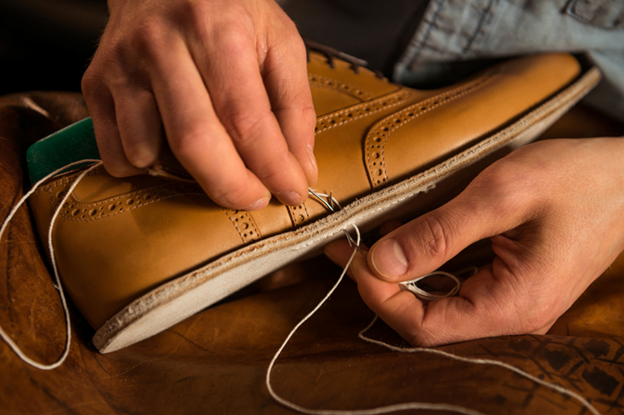Indeed, in today’s world, innovation is no longer a matter of the silhouette or the outsole — but all the way through, literally. The thread is one essential and often overlooked factor that determines the shoe’s performance, durability, and even style. Today’s footwear needs to be modern and satisfy the demands of the changing needs of athletes, stylish consumers, and industrial workplace professionals. Constant attack on the threads that stitch shoes together comes from heat, friction, repeated flexion, environmental exposure, and more.
In this article, we explore how thread technology has evolved to maximize use and meet the cruel demands of the footwear industry today. In material science, performance metrics, environmental considerations, and innovative design, we’ll explore how thread is being transformed to redefine what things can do.
The Silent Backbone of Shoe Construction
A shoe is made up of every stitch that has a purpose. It secures the upper to the midsole, links it to the high-stress areas, and is often than not is decorative. Indeed, what these stitches do is more than sit still—they flex, stretch, rub, heat up, and absorb impact with each step.
The Challenge
Modern shoes are subjected to extreme environments:
- There are high-speed movements, heat from friction, and rapid directional changes that are produced by athletic footwear.
- Outdoor and work footwear face moisture, temperature swings, abrasion, and chemical exposure.
- Fashion and lifestyle footwear must hold both form and color over time and have delicate or strange materials.
In that case, the threads have to stand up to:
- Frictional heat and heat from manufacturing processes.
- Friction during wear and stress.
- Repeated movement, compression, and bending.
We will take these apart in the context of how thread technology fulfills each demand.
Heat Resistance: Threads That Keep Their Cool
The secret weapon against the heat of footwear is not shoes. It appears during use, from friction, body warmth, or the surroundings, and during production, especially in high-temperature processes like cementing, autoclaving, and heat-molding.
Key Considerations
- Thermal stability: Threads need to preserve tensile strength and structural integrity at high temperatures.
- Melt point vs. degradation point: Even if a thread does not melt, it may become brittle or weaken under extended heat exposure.
- Colorfastness: Elevated temperatures can alter or fade dyes, impacting the shoe’s appearance.
Advanced Thread Materials
Contemporary thread manufacturers utilize high-performance fibers that withstand heat:
- Meta-aramid (e.g., Nomex®): Employed in firefighting boots, it withstands temperatures up to 370°C without melting.
- PTFE-coated polyester or aramid: Merges heat resistance with low friction and chemical durability.
- Para-aramid (e.g., Kevlar®): With a decomposition point exceeding 500°C, it is suitable for extreme-duty footwear.
These materials enable manufacturers to reliably use threads in shoes that experience industrial sterilization, heated pressing, or high-friction sports activities.
Friction Resistance: Fighting Abrasion, Stitch by Stitch
Friction is unavoidable in footwear. It happens during the production and use of shoes—whether it’s the needle of the sewing machine passing through layers or the sole bending during a marathon.
- Areas of High Friction
- Eyelets and lace paths
- Toe boxes and heel counters
- Midsole-heel junctions
- Seam reinforcements (e.g., around logos or overlays)
Thread Engineering for Friction
To withstand this wear, threads must endure:
Surface abrasion
Snagging
Pilling
Loss of coating or finish
Solutions in Practice
- Bonded threads: These feature a smooth polymer coating that resists wear and facilitates smooth passage through fabric.
- Monocord threads: Single-filament construction minimizes the likelihood of thread breakage due to surface friction.
- Twisted multifilament polyesters with anti-wick finishes: These inhibit moisture intrusion and lower yarn-on-yarn friction.
- PTFE coating: Reduces surface tension, allowing for smoother movement and improved chemical resistance.
Thread innovations like these guarantee durability even in high-stress settings, such as hiking, cross-training, or industrial jobs.
Flex Durability: Withstanding the Repetition
One of the toughest evaluations for any shoe component is repeated flexing. Each step bends, elongates, and compresses the shoe, and over time, these actions can deteriorate even the strongest materials.
Performance Metrics
- Flexural fatigue resistance: The capacity to withstand thousands of flexes without breaking.
- Elastic recovery: Returning to the original length after being stretched.
- Seam integrity: Preventing seam creep or bursting due to thread elongation.
Flex-Tolerant Threads
New threads for flexible footwear consist of:
- Texturized polyester sewing thread and nylon sewing thread: Provides elasticity and flexibility for lightweight trainers and casual shoes.
- Stretchable cores (e.g., covered elastomeric threads): Allow the thread to stretch and recover with the fabric, making them suitable for knitted uppers and sock-fit designs.
- Core-spun threads: Merge a strong filament core with a soft outer wrap for flexibility and tactile comfort.
In performance evaluations, many of these threads can withstand over 100,000 flex cycles without failure, making them perfect for uses ranging from running to casual wear.
Engineering Seam Design Around Thread Capabilities
The strength of the thread is only a portion of the equation—how it is used is equally crucial. Footwear designers need to select seam types, stitch density, and tension adjustments based on thread capabilities.
Common Seam Types and Their Applications
Double-needle lockstitch: Sturdy for midsoles and outsole attachment.
- Zigzag or multi-needle stitching: Flexible-friendly, utilized in performance footwear.
- Bartack reinforcements: High-stress areas like lace loops and heel tabs.
Seam Optimization Tips
- Align thread with material: Employing a thread that stretches with the upper prevents seam failure.
- Minimize seam allowance bulk: Reduces stiffness and hot spots in flex areas.
- Employ differential feed in sewing: Prevents puckering and inconsistent tension, especially with knits and synthetics.
The Future: Smart Threads and Sustainable Solutions
The footwear industry is on the verge of a transformation in thread technology—not only stronger threads but also smarter and eco-friendlier ones.
- Conductive threads: Facilitate smart shoes with sensors for gait analysis, step tracking, or medical supervision.
- Color-changing threads: Thermochromic or photochromic traits that respond to temperature or light.
- Shape-memory threads: React to heat and revert to a predefined shape—perfect for dynamic fit systems.
Final Stitch: Small Thread, Massive Impact
The best footwear designs are seamless in both form and function, and thread is the connective tissue that makes that possible. Unheralded, but heralded, threads are the heroes of the performance running shoe, adornment of high fashion boo, and the heat, flexing and frictions of life today.
In recent decades, materials science has made great strides in the area of materials for thread, and sustainability demands, as have the ever-present demands for highly specialized footwear. Daily, shoes reinvent themselves, and threads continue to do the same.





